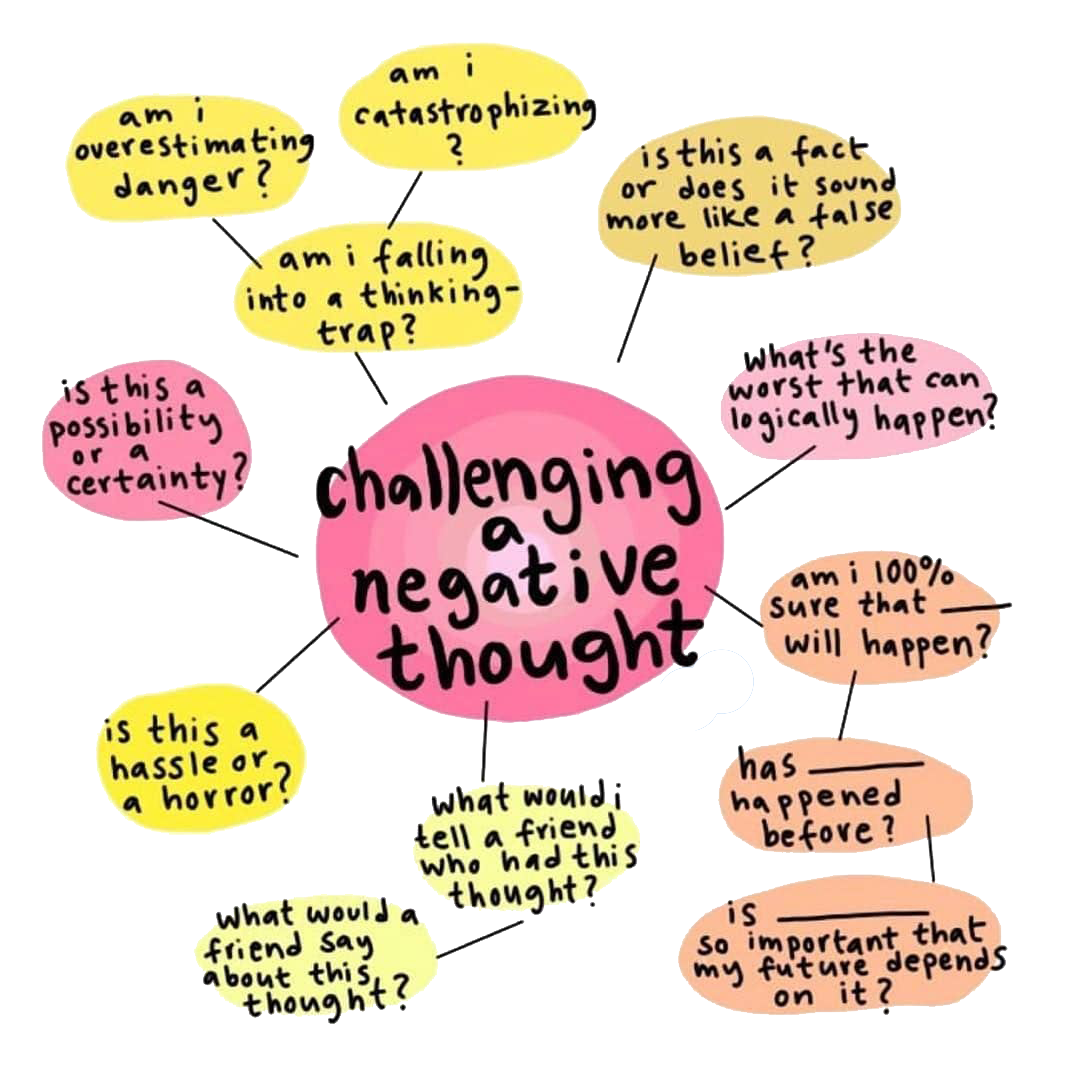How To Reframe Negative Self Talk
- Ch: 1.6 of How To Get Your Sh!t Together -
The first step to reframe negative self talk is to notice the quality of your thoughts.
“Thoughts, by their nature, come and go endlessly in you. But you are not thought; you are the one seeing the thought, so any thought of who you are cannot be the truth of who you are.” - Enza Vita
Thoughts of worthlessness, poor self-image, lack of belief in your own abilities, failure, and social out-casting, can run rampant in the mind and detrimentally impact your ability to function.
I know from first-hand experience the negativity cycle that these thoughts can put you into. When I am suffering from anxiety or depression, these thoughts can become particularly powerful.
They play on a loop in my mind, getting ever louder. The more they play, the more that I am negatively impacted. My functionality drops as I am less and less able to do the things I usually do. These losses ‘prove’ that the voices in my head are right.
The longer the negative self-talk goes on, the more I am impacted by it and therefore the more ‘right’ those thoughts are. They start to become truth, and when they arise again, they are instantly more credible.
Unfortunately, the more you allow this process run, the harder it is to reframe negative self talk. You can’t just stop those kind of thoughts and think positive. Attempting to will a thought away will inevitably make that thought stronger because you are focusing on the thought and giving it weight.
Think of how many thousands of thoughts you have each day. Most come and go freely right? But the ones that you latch onto, the ones that you focus on, stay around.
Attempting to ‘not think of something’ only makes you think of it more.
If you try to not think of something you will fail. Don’t believe me? I’ll prove it to you.
TAKE ACTION
Carrot.
For the next 30 seconds, don’t think of a carrot. Once this paragraph is over the time begins and you are not allowed to think of a carrot at all.
Do you think you can last 30 seconds without the thought of a carrot popping into your mind? I doubt it, but I want you to try.
Are you ready? Carrot!
Why You Can’t Stop Thinking About Someone
How did you go? Impossible right? And that was just for a neutral object. Imagine how hard it would be to ‘just stop thinking about it’ if it was something more emotionally significant, like death, or a break up?
Imagine that you have just had a bad break up with, who you thought to be, the love of your life. Understandably you are feeling vulnerable and heart broken.
Thinking of your past with that person hurts. To prevent further suffering, you may have even taken steps to remove the reminders of them from your life – deleted them off social media, thrown out their photos and blocked their number. Yet you are still triggered into remembering them, and of course you are still suffering. People say that time heals all wounds, but it feels like every time you remember them, those wounds open up afresh.
You just can’t get them out of your mind.
So when a thought of that person arises, you do your best to not think of the person. You try to drive it out of your mind and ‘think of something else’. This of course, does not work. They are stuck there, and you begin to ruminate over them and berate yourself with negative self-talk for not being stronger and for not getting over them sooner.
It would be impossible for you to just stop thinking of them. Yet that is just what we are told to do when we have negative thoughts in our minds that are impacting our lives. How many times have you heard a variation of the following statements?
‘Make sure your own worst enemy is not living between your ears.’
‘A negative mind will never give you a positive life.’
‘If you think you can’t you won’t.’
‘Don’t think about what might go wrong and start thinking about what could go right.’
‘Be careful of how you are talking to yourself, because you are listening.’
see what i mean?
These statements are often taken as an offence within the mental health community.
“Think positive, why didn’t I think of that? My anxiety and depression are cured! Thank you!”
Cultivating a positive mindset is of course necessary if you want to lift yourself out of mental illness and to begin following your dreams. The problem is that those statements, when given alone, don’t provide the person with any practical advice on how to think positive.
It is not enough to be told to think positive, or that negative thoughts are bad for you. You need a method to address the thoughts, to take away their power, and to change them into something less harmful.
Reframing Negative Self Talk Example
The concept of detaching from your thoughts is ubiquitous to mindfulness meditation guides and self-help books. However, the explanation of exactly how to detach from your thoughts is often lacking. Readers are left with unclear instructions on what they can actually do to detach.
This is not the case in ‘The Happiness Trap’. In this amazing book, Russ Harris provides a clear process that is easy to implement and requires no meditation experience. It also avoids any use of misleading esoteric wording.
I’ll summarize the exercise below.
TAKE ACTION
1) Take any example of negative self-talk that you are experiencing and state it.
“I am worthless.”
2) Now place the phrase “I am having the thought that” in front of your negative self-talk statement.
“I am having the thought that I am worthless.”
3) Repeat this process adding “I notice that” to the beginning of your statement.
“I notice that I am having the thought that I am worthless.”
This process can be applied to any thought that is plaguing you. Take the idea from above of a difficult break up.
“I will never find someone like them again” becomes “I am noticing that I am having the thought that I will never find someone like them again.”
Give this a try now with any thoughts that are bothering you. Notice any changes in your mental state?
—
Despite how it may feel at the time, the thought of “I am worthless” is not true. This exercise helps you to detach from the thought and take away its power. By adding “I notice that I am having the thought that…” You are stepping back and simply noticing the thought – rather than immediately accepting it.
It can help you to put the troubling thoughts back in their place by highlighting that they are less significant than you first accepted them as being.
Frequently Asked Questions
Q) What if my mind is such a blur of anxiety or ruminations that I can’t define a specific thought to focus on?
A) An anxious mind can often become so busy that it feels like a cloud of static, or five radios playing simultaneously. When this occurs, defining an individual thought can be impossible.
You can still use the technique however. Instead of specifying an individual thought, instead you can talk about the cloud of thoughts itself.
“Cloud of indistinguishable thoughts’ becomes ‘I am noticing that I am having a cloud of indistinguishable thoughts’.
This won’t necessarily stop the cloud of course, but it may lessen its debilitating impact.
Q) Sometimes these thoughts are so strong that I cannot detach, I feel like I am merely paying it lip service.
A) This may happen, particularly when you first start using the technique, so please keep at it.
I would also suggest combining this exercise with an exercise that focuses on targeting the physical side of anxiety, like Ten Relaxation Breaths or Full Body Sweep. The relaxation effects of those exercises may be enough to take some of the edge off the anxious thoughts.
‘Meditation’ is designed to cultivate detachment from thoughts. Check that chapter out for some more advice and exercises that will further assist you with this exercise.
Resources
The Happiness Trap, Russ Harris
The Mind Illuminated, John Yates
Mindfulness In Plain English, Bhante Gunaratana
Summary
Trying to ‘not think of something’ is impossible. Instead try to detach from those thoughts by mentally adding ‘I notice that I am having that thought that…’ prior to the negative self-talk.
If this post has resonated with you, I would love your support.
Read Next:
Meditation - The Single Best Thing You Can Do For Your Mental State Every Day
Just Take A Breath - The Cliché Advice That Actually Works
Read another chapter from How To Get Your Sh!t Together. Download a free copy here or purchase as a Paperback, eBook, or Audiobook.
Your shadow is the gateway to a more authentic you.
This course is your guide to profound inner work. Through powerful insights, guided prompts, and proven techniques, you'll navigate your shadow, heal unresolved wounds, and reintegrate the parts of yourself you’ve long ignored.
What’s Inside:
12 x Guided Meditation & Contemplations
12 x Introspective Prompts
12 x Expansion Challenges
A comprehensive instructional PDF guidebook
Unlimited email coaching for ongoing support and personalized guidance
Explore full course details and watch intro video here!
This isn’t just about healing, it’s about meeting your shadow head-on, embracing every part of yourself, and reclaiming your full power.
Are you ready to face what’s been hidden and step into your truth?




